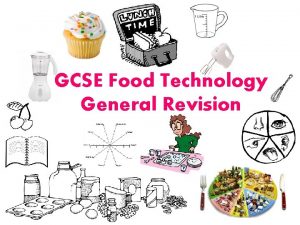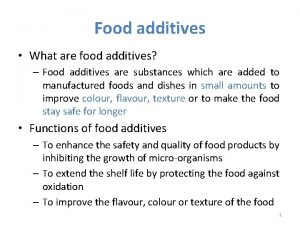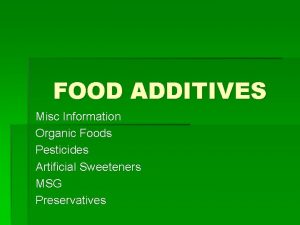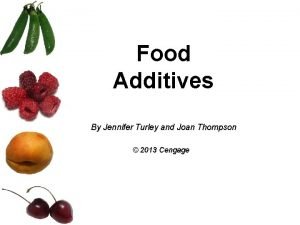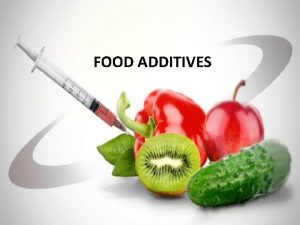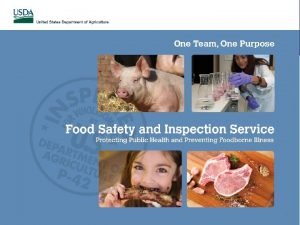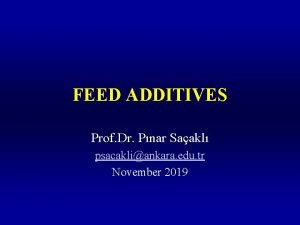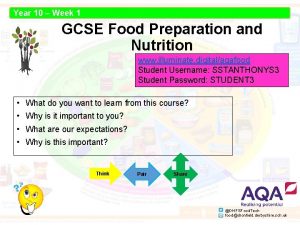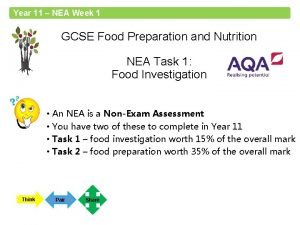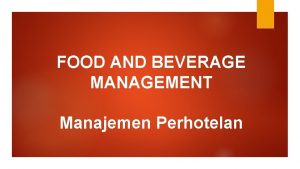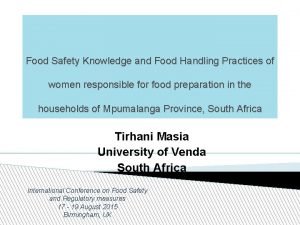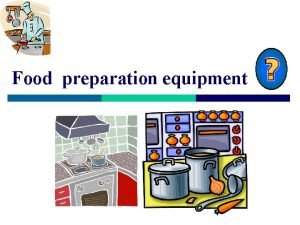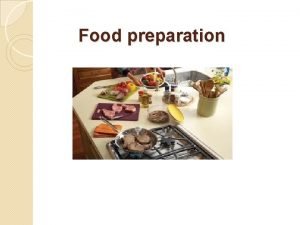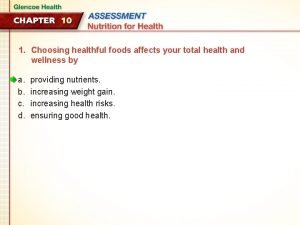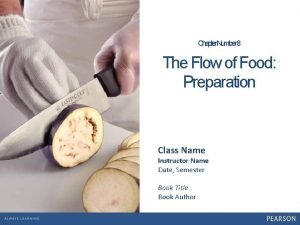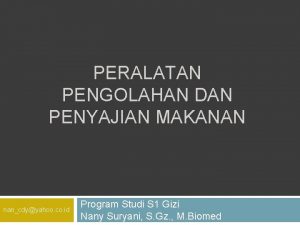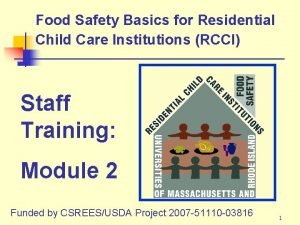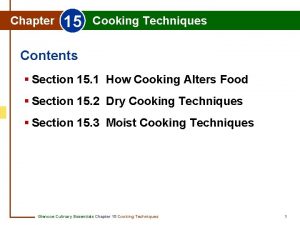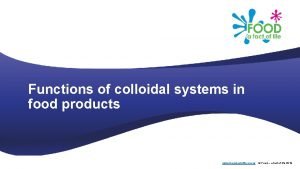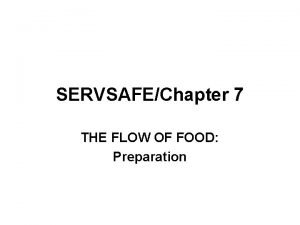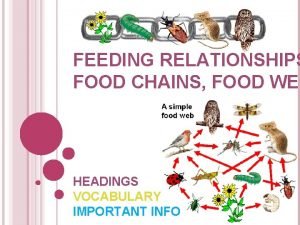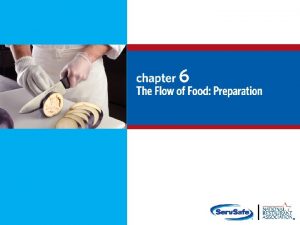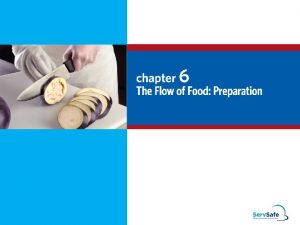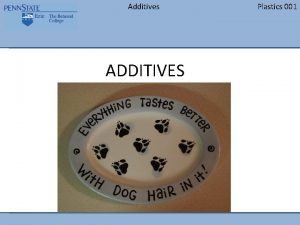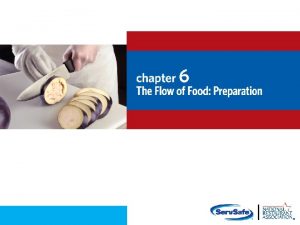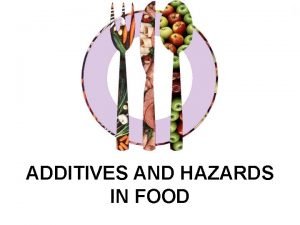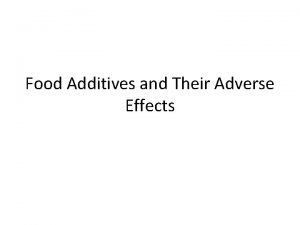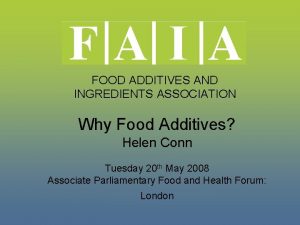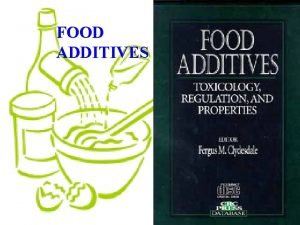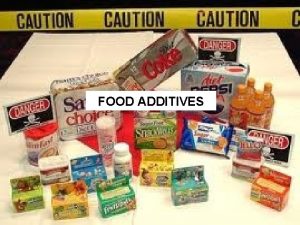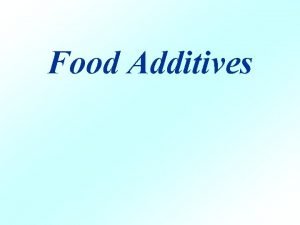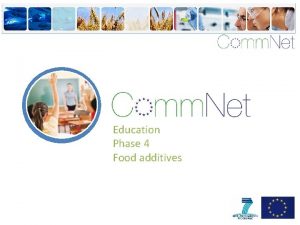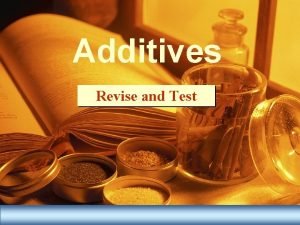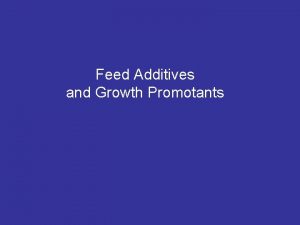General Preparation Practices Food and color additives 6

































- Slides: 33


General Preparation Practices Food and color additives: 6 -2 l Only use additives approved by your local regulatory authority l _______ use more additives than are allowed by law l ________ use additives to alter the appearance of food l Do NOT sell produce treated with sulfites before it was received in the operation l ________add sulfites to produce that will be eaten raw

General Preparation Practices Present food honestly: l l 6 -3 Do NOT use the following to misrepresent the appearance of food o Food additives or color additives o Colored overwraps o ________ Food not presented honestly must be thrown out

General Preparation Practices Corrective actions: l 6 -4 Food must be thrown out in the following situations o When it is handled by staff who have been restricted or excluded from the operation due to illness o When it is contaminated by hands or bodily fluids from the nose or mouth o When it has exceeded the time and temperature requirements designed to keep food safe

Thawing Four Methods for Thawing Food 7 -3 1. Thaw food in a cooler, at a product temperature of _____°F (5°C) or lower 2. Submerge food under running water at 70°F (21°C) or lower 3. Thaw food in a _________, only if cooked immediately after thawing 4. Thaw as part of the __________process

Prepping Specific Food Produce: l l 6 -5 Produce can be washed in water containing ozone to sanitize it o Certain chemicals may be used to wash fruits and vegetables. Also, produce can be treated by washing it in water containing ozone. This treatment helps control pathogens. o Check with your local regulatory authority When soaking or storing produce in standing water or an ice-water slurry, do NOT mix o Different items o Multiple batches of the same item

Prepping Specific Food When prepping eggs and egg mixtures: l l 7 -8 Handle ________eggs (if allowed) with care: o Cook promptly after mixing or store at 41°F (5°C) or lower o Wash and sanitize containers between batches Consider using ___________ shell eggs or egg products when prepping dishes requiring little or no cooking

Prepping Specific Food When prepping eggs for high-risk populations: l Use pasteurized shell eggs if eggs will be pooled l Use pasteurized eggs or egg products when serving raw or undercooked dishes o 7 -9 Unpasteurized shell eggs can be used if the dish will be cooked all the way through (i. e. , omelets, cakes)

Prepping Specific Food When prepping salads containing TCS food: l Make sure leftover _____ ingredients (i. e. , pasta, chicken, potatoes) have been handled safely by ensuring that they were: o Cooked, held, and cooled correctly o Stored for less than ______ days at 41°F (5°C) or lower • Chicken, tuna, egg, pasta, and potato salads all have been involved in foodborne-illness outbreaks. These salads usually are not cooked after preparation. This means you do not have a chance to get rid of pathogens, like hepatitis A, that may have gotten into the salad when it was made. • Check 7 -10 the use-by date before using leftover TCS food in salads.

Prepping Specific Food Ice: 6 -6 l _________ use ice as an ingredient if it was used to keep food cold l Transfer ice using clean and sanitized containers and scoops l NEVER hold ice in containers that held chemicals or raw meat, seafood, or poultry

Prepping Specific Food Ice: 6 -7 l Store ice scoops outside ice machines in a clean, protected location l NEVER use a glass to scoop ice or touch ice with hands

Preparation Practices That Have Special Requirements You need a variance if prepping food in these ways: 6 -8 l Packaging fresh juice on-site for sale at a later time, unless the juice has a warning label l ________food to preserve it but not to enhance flavor l Using food additives or components to preserve or alter food so it no longer needs time and temperature control for safety l ________ food

Preparation Practices You need a variance if prepping food in these ways: 6 -9 l Packaging food using a reducedoxygen packaging (ROP) method l Sprouting _____ or _______ l Offering live shellfish from a display tank l Custom-processing animals for personal use (i. e. dressing a deer)

Cooking Food When cooking TCS food, the internal portion must: 7 -16 l Reach the required minimum internal temperature l Hold that temperature for a specific amount of time

Cooking Requirements for Specific Food Minimum internal cooking temperature: ______°F (74°C) for 15 seconds 6 -10 l __________—whole or ground chicken, turkey, or duck l Stuffing made with fish, meat, or poultry l Stuffed meat, seafood, poultry, or pasta l Dishes that include previously cooked, TCS ingredients

Cooking Requirements for Specific Food Minimum internal cooking temperature: ______°F (68°C) for 15 seconds l l l 6 -11 Ground meat—beef, pork, and other meat Injected meat—including brined ham and flavor-injected roasts Mechanically tenderized _______ Ratites including ostrich and emu Ground seafood—including chopped or minced seafood Shell eggs that will be hot-held for service

Cooking Requirements for Specific Food Minimum internal cooking temperature: _______°F (63°C) for 15 seconds 6 -12 l ___________— including fish, shellfish, and crustaceans l Steaks/chops of pork, beef, veal, and lamb l Commercially raised game l Shell eggs that will be served immediately

Cooking Requirements for Specific Food Minimum internal cooking temperature: 145°F (63°C) for four minutes l Roasts of pork, beef, veal, and lamb l Alternate cooking times/temperatures o o o o 6 -13 o 130°F (54°C) 131°F (55°C) 133°F (56°C) 135°F (57°C) 136°F (58°C) 138°F (59°C) 140°F (60°C) 142°F (61°C) 112 minutes 89 minutes 56 minutes 36 minutes 28 minutes 12 minutes 8 minutes

Cooking Requirements for Specific Food Minimum internal cooking temperature: ________°F (57°C) l 6 -14 Fruit, vegetables, grains (rice, pasta), and legumes (beans, refried beans) that will be hot-held for service

Cooking TCS Food in the Microwave Minimum internal cooking temperature: _______°F (74°C) 7 -22 l Meat l Seafood l Poultry l Eggs

Cooking TCS Food in the Microwave When cooking food in a microwave: 7 -23 l Cover it to prevent the surface from drying out l Rotate or stir it halfway through cooking so heat reaches the food more evenly l Let it stand for at least 2 minutes after cooking to let the food temperature even out l Check the temperature in at least 2 places to make sure the food is cooked through

Apply Your Knowledge: What’s the Temperature? What is the minimum internal cooking temperature for each of these items? 1. Salmon steak 2. Green beans that will be hot held 3. Ground pork 4. Lamb chops 5. 6. 7. 8. 9. Eggs for immediate service Duck Black beans Steak Chicken enchiladas prepared with previously cooked chicken 10. Pork loin injected with marinade 8 -22

Partial Cooking During Preparation If partially cooking meat, seafood, poultry, or eggs or dishes containing these items: 6 -15 l _______ cook the food longer than ______ minutes during initial cooking l Cool the food immediately after initial cooking l _______ or refrigerate the food after cooling l Heat the food to at least _______˚F (74˚C) for 15 seconds before selling or serving l Cool the food if it will not be served immediately or held for service

Consumer Advisories If your menu includes raw or undercooked TCS items, you must: l l Note it on the menu next to the items o ___________ the item o Place a footnote at the menu bottom indicating the item is raw, undercooked, or contains raw or undercooked ingredients Advise customers who order this food of the increased risk of foodborne illness o 6 -16 Post a ________ in the menu

Consumer Advisories The FDA advises against offering these items on a children’s menu if they are raw or undercooked: 6 -17 l _______ l Poultry l _________ l Eggs

Operations That Mainly Serve High-Risk Populations ____________serve: 6 -18 l Raw seed sprouts l Raw or undercooked eggs, meat, or seafood o Over-easy eggs o Raw _________ on the half shell o _______ hamburgers

Storing Food for Further Cooling When storing food for further cooling: l Loosely ________ food containers before storing them l Food can be left uncovered if protected from contamination o 6 -19 Storing uncovered containers above other food, especially raw seafood, meat, and poultry, will help prevent crosscontamination

Cooling Food Cooling Requirements Two Stage Cooling Method: • First, cool food from _____˚F to _______˚F (57˚C to 21˚C) within two hours. • Then cool it to _____˚F (5˚C) or lower in the next four hours. • If food has not reached _____˚F (21˚C) within two hours, it must be thrown out or reheated and then cooled again. 7 -26

Cooling Food If you cool food from 135˚F to 70˚F (57˚C to 21˚C) in less than _______ hours: l Use the remaining time to cool it to 41˚F (5˚C) or lower l The total cooling time cannot be longer than ______ hours Example: 7 -27 l If you cool food from 135˚F to 70˚F (57˚C to 21˚C) in 1 hour l Then you have 5 hours to get the food to 41˚F (5˚C) or lower

Methods for Cooling Food Before cooling food, start by reducing its size: 7 -28 l Cut larger items into _______ pieces l Divide large containers of food into smaller containers or shallow pans

Methods for Cooling Food Safe Methods for Cooling Food 7 -29 l Place it in an ice-water bath l Stir it with an ice paddle l Place it in a blast chiller l Place it in a tumble chiller

Reheating Food reheated for immediate service: l Can be __________ to any temperature if it was cooked and cooled correctly Food reheated for hot-holding: 6 -20 l Must be reheated to an internal temperature of ________°F (74°C) for 15 seconds within two hours l Reheat commercially processed and packaged ready-to-eat food to an internal temperature of at least 135°F (57°C)

Apply Your Knowledge: Load the Fridge Store each item on the proper storage shelf 1 2 A Whole, raw meat C Cooked and ready-to-eat food 3 4 B Raw poultry D Raw ground meat 7 -21
 Natural and artificial food additives
Natural and artificial food additives Food technology revision
Food technology revision Color additives amendment
Color additives amendment Food additives examples
Food additives examples Msg pesticide
Msg pesticide Intentional food additives
Intentional food additives Substance added to food
Substance added to food Vehicle present in the linctuses is
Vehicle present in the linctuses is Example of plasticizer
Example of plasticizer Food safety and inspection service definition
Food safety and inspection service definition Feed additives classification
Feed additives classification High performance additives
High performance additives Unit 2 food food food
Unit 2 food food food Grazing food chain diagram
Grazing food chain diagram Gcse food tech high skill dishes
Gcse food tech high skill dishes Nea food tech example
Nea food tech example Pengertian food and beverage product
Pengertian food and beverage product Improper food handling practices
Improper food handling practices Auxiliary cooking equipment examples
Auxiliary cooking equipment examples Preparation food meaning
Preparation food meaning Total health foods
Total health foods Flow of food: preparation
Flow of food: preparation Contoh alat penyajian
Contoh alat penyajian Used to measure heat intensity in food preparation
Used to measure heat intensity in food preparation Complex food preparation
Complex food preparation Cooking methods vocabulary
Cooking methods vocabulary Definition of colloid systems in food preparation?
Definition of colloid systems in food preparation? The flow of food preparation
The flow of food preparation Food preparation activities
Food preparation activities Diferencia entre gran plano general y plano general
Diferencia entre gran plano general y plano general Where did general lee surrender to general grant?
Where did general lee surrender to general grant? Food chain
Food chain Food chains are interconnecting food webs
Food chains are interconnecting food webs Food chain relationships
Food chain relationships

